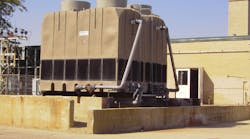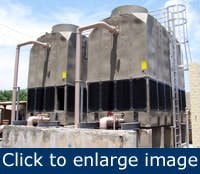The hot summer and fall months place inordinate demands on cooling systems, so if your cooling tower and related equipment aren’t in good physical shape, there could be a terrible price to pay in loss of process efficiency, damage to downstream equipment, and loss of production.
Like overheating the engine in your car, the loss of cooling capability from industrial cooling towers during hot summer months can result in a number of serious consequential systemic problems, including paralyzing and pricey damage such as excessive downtime, equipment destruction, and product loss caused by quality problems.
[pullquote]“Like your car, when you run a cooling tower in the red, you’re going to see consequential damage,” advises Tom Ryder, an engineer with Delta Cooling Towers, a manufacturer of plastic cooling towers. “When you run a car in the red continuously during the heat of summer, you’re exposing yourself to a series of heat-related problems, including damaged gaskets and seals, premature cylinder wear, warped cylinder heads, and even catastrophic engine damage. When a cooling tower is suffering from a lack of preventive maintenance, you could experience overheated equipment, increase in scrap material, refrigeration losses, heat exchanger inefficiencies, and other severe operational consequences.”
Ryder uses the car analogy because he says most people can relate to it, whereas many don’t quite appreciate the relationship of a cooling tower’s influence on overall process cooling, including the production losses and potential for equipment damage.
Cooling towers play a critical role in cooling process equipment used in pulp and paper production; petrochemical processing; manufacture of plastics, metals and textiles; the processing and storage of food, beverage and pharmaceutical products; and many HVAC systems.
Cooling towers play a role in cooling process equipment used in pulp and paper production, petrochemical processing, manufacture of plastics, metals and textiles, the processing and storage of food, beverage and pharmaceutical products, and many HVAC systems.
Ryder explains that if cooling towers aren’t kept in good shape and receive preventive maintenance, the ambient heat during the summer months will detract from their cooling capacities, leaving them “fatigued,” which can put a strain on downstream system equipment and processes.
Even if the downstream equipment isn’t affected by hot weather directly, the cooling tower is, explains Ryder. “Therefore, unless the cooling tower is well maintained, the water it provides to devices such as heat exchangers, production machinery and HVAC systems will be less able to draw off heat. For example, the ‘cold side’ of a heat exchanger will receive water that isn’t as cool as optimum. Therefore, the heat exchanger will be less able to draw off heat from process fluids.”
If the cooling tower shell is in bad shape or requires too much repetitive maintenance, then perhaps the system should be replaced with one of today’s more advanced models, such as the seamless plastic cooling tower.
A high price to pay
The cost of overlooking cooling tower maintenance can be heavy, regardless of application, warns Ryder. In the pulp and paper industry, for example, a process interruption for unscheduled service can run into hundreds of thousands of dollars.
“The same thing can occur in chemical processing. If you don’t cool that equipment sufficiently, forget the normal fears about downtime,” says Ryder. “You’re going to be repairing and replacing hardware, so you’ll have an impact that is both loss of production and loss of capital equipment.”
The damage can be amplified in applications where there are cooling towers operating with sometimes dozens of devices daisy-chained off them.
“That is often the situation in the injection molding industry,” he says. “So you have to be concerned about downtime plus the loss of machinery that is vital to your application. If the cooling tower isn’t cooling enough and causes a series of injection molding machines to overheat, the expensive molding equipment is going to produce scrap parts or just going to lock up like a seized engine. It could take weeks to replace the equipment, if necessary, and certainly days to clean it up, if no catastrophic damage has occurred.”
In the food industry, where a cooling tower supports critical food processing machinery and the HVAC system, as well as refrigerators and freezers, the loss of even part of the cooling capability can cause extensive losses of frozen products, produce, or other perishable products.
Both routine and preventive
Just as with automobiles, the need for cooling tower maintenance – both routine and preventive - is more pronounced in the summertime. Fill material or wet decking should be serviced or replaced. Fouled fill material won’t allow sufficient air volume to contact the system’s water to dissipate heat efficiently. Therefore, it’ll make the fan(s) and motors work harder, adding significantly to energy costs or, worse, make them unable to achieve required cooling temperatures.
“If you’re running water through fouled cooling tower wet decking, you’ll not get the necessary heat dissipation, and the water getting down to the sump won’t be cold enough for the processing equipment,” adds Ryder. “Wash down the ventilation louvers, as well as the wet decking, which facilitate the cooling evaporation process. Check drift eliminators to prevent unnecessary water loss. Plus, make any repairs such as patching, welding or cleaning of cooling tower sheeting as required.”
“Like you car, when you run a cooling tower in the ‘red,’ you are going to see consequential damage,” advises Tom Ryder, a longtime cooling tower customer support specialist.
Cooling towers cool water through heat transfer and evaporation. With a loss of 1% water for every 10°F of cooling required, the evaporation factor can be significant – 20 or 30 gal./min. isn’t uncommon for small towers. When evaporation occurs, scale is left behind, which can interfere with cooling tower efficiency and require expensive maintenance or acid cleaning. Because plastic cooling towers are impervious to residual salts, the tower can’t be damaged and fill material can be cleaned by most aggressive de-scalers. Metal towers, on the other hand, can be irreparably harmed by de-scalers, causing a premature whole tower rebuild or replacement.
Replace vs. repair
Ryder says that sometimes preventive maintenance isn’t enough, or perhaps has been overlooked for too long, making cooling tower replacement the most practical solution.
“To use the automobile example, when you’re spending more than a couple of thousand dollars a year in maintaining your car, you might weigh that expense against spending a couple of thousand dollars a year in payments for a brand-new car,” he says. “The same consideration might apply to cooling towers, particularly the old, metal-clad designs that require and are sensitive to frequent chemical treatments, patching and welding.”
He adds that a seamless engineered-polyethylene shell cooling tower offers a lower cost of ownership because overall maintenance is minimal and the tower shell doesn’t require preventive maintenance, nor does it have to be relined or repaired.
“But even a cooling tower as durable as these plastic models still should receive inspection and maintenance in preparation for hot weather,” says Ryder. “You should clean the PVC fill or packing material, you should ensure the louvers are clean for optimum air flow and minimize need of the electric fan, and you should ensure that drift eliminators are operational. That will go a long way toward avoiding cooling tower fatigue for many years to come.”
Ed Sullivan is a technology writer based in Hermosa Beach, Calif. Tom Ryder from Delta Cooling Towers, Inc. in Rockaway, N.J. can be reached at (800) 289-3358 and www.deltacooling.com.


